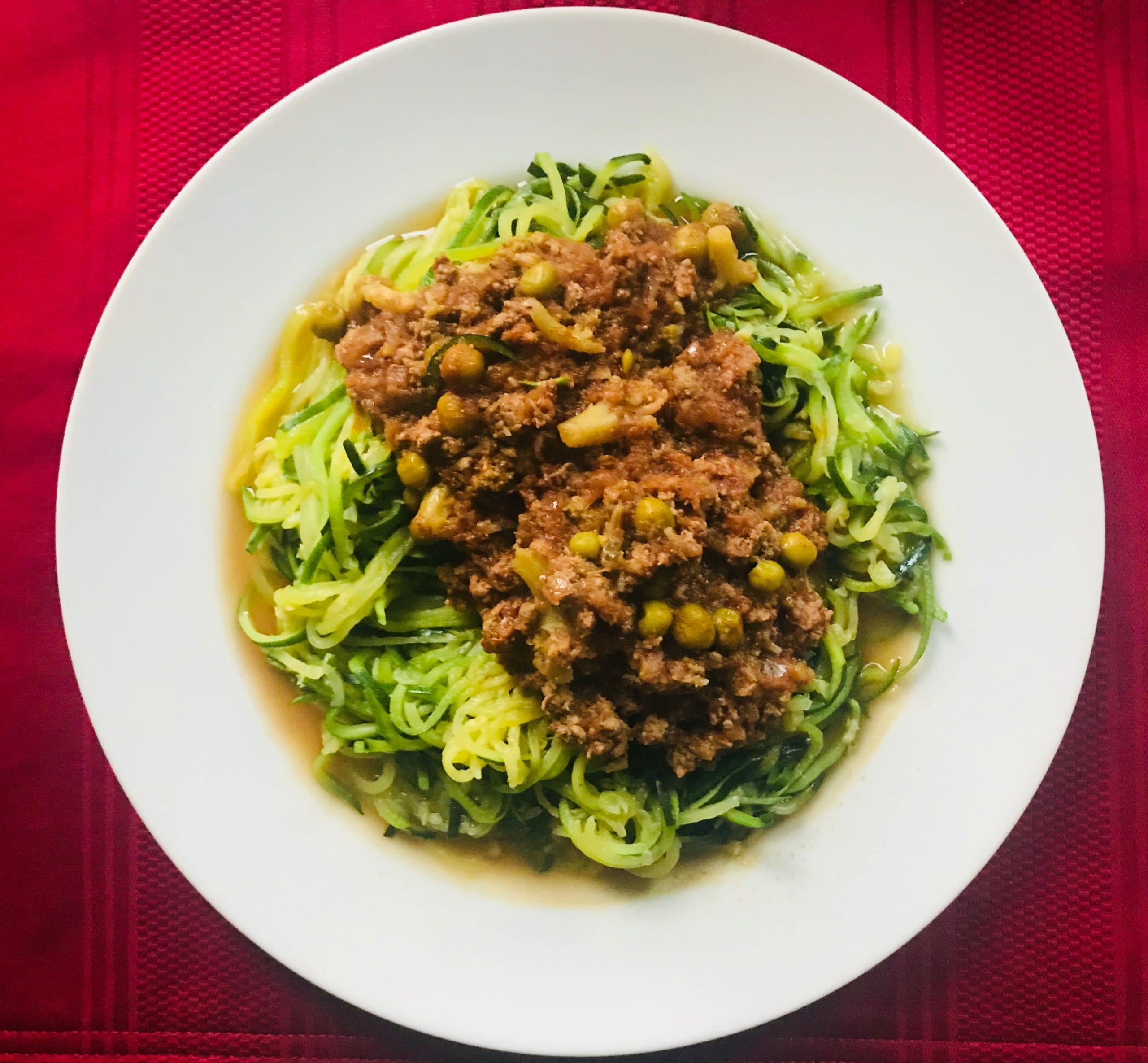A spiced ground lamb-veg ragu is one of my favorite one-pot comfort food dishes any day, but especially on a cold winter night.
A ragu is toothsome, delicious and budget-friendly. You can make a simple ragu of onions, garlic, spices, ground lamb and strained tomatoes or one that is loaded with vegetables (my choice, and I like to load up on peas, broccoli and zucchini). You can easily “stretch” out a ragu…if I make a ragu for dinner, I like to warm up leftovers for breakfast. But I thin out the ragu by adding enough filtered water so that it is almost soupy. And, on a cold winter morning, a warm “soupy” bowl of ragu is both a soothing and energizing way to start the day.
Personally, I prefer pasture-raised lamb to beef. Sheep are herbivores, eating only plants (grass and berries). Yet, even “local” lamb are fed a diet that consists of grain. Conventionally raised feedlot lambs may start out eating grass, but they are finished on grains, like corn, barley or soybean meal, to fatten them up. Because grains are not part of their natural diet and difficult for herbivore ruminants (like lamb) to digest, a lamb can experience liver failure if it overconsumes grain.
Lambs fed high-grain diets are also at risk of intense pain or sudden death from acidosis (a.k.a., “grain overload” or “grain poisoning”, where a build-up of lactic acid results in a slowing of the gut, dehydration and often death), enterotoxemia (a fatal disease resulting from a build-up of bacterial poisons in the gastrointestinal tract of sheep and lamb when they overconsume grains) and urinary calculi (a urinary tract condition that can prevent urination and breeding in males).
So…before buying lamb, ask if it is grass-fed andgrass-finished. I will only buy lamb that is 100% grass-fed; this may mean that my lamb is from Australia, New Zealand or Iceland.
Lamb is a nourishing, satisfying and substantive source or protein. It is also an underappreciated source of omega 3 fatty acids, typically associated with foods like salmon, sardines, flaxseed and walnuts: 100% grass-fed lamb will contain at least 25% more omega-3 (good) fat than conventionally raised lamb. Lamb is also rich in vitamins and minerals—such as selenium, zinc, B12, niacin and iron1—that nourish the thyroid, a gland located below and behind your Adam’s apple that produces thyroid hormone, essential for all bodily functions, including metabolism, energy, digestion, sex drive and growth of hair and nails.
Grass-fed lamb is an excellent food source of selenium and zinc, two minerals that are vital to thyroid and immune health. Studies link adequate selenium intake with reduced inflammation and damage to thyroid tissue in Hashimoto’s, an autoimmune thyroid disease.2Sufficient zinc is also needed to help make—and activate—thyroid hormone (T3). As an antioxidant and anti-inflammatory agent, zinc is vital for the proper functioning of the immune system, like the production of white blood cells. Zinc deficiency can actually hinder the immune response.3
Savor a delicious way to be good to your body!
Spiced Ground Lamb & Veg Ragu
1 pound pasture-raised OR 100% grass-fed (and grass-finished) ground lamb
1 tablespoon organic raw or organic unrefined coconut oil
1 medium onion, chopped fine (or buzz in food processor)
2 cloves garlic, minced (or buzz in food processor)
Optional: 1 serrano chile, well rinsed, ends discarded, finely minced
(seeds included)
1 cup minced zucchini
1 teaspoon cinnamon
1/2 teaspoon nutmeg
1/4 teaspoon cardamom
10 to 12 oz. organic strained tomatoes
2 to 3 cups cooked organic frozen broccoli florets OR 2 to 3 cups steamed
broccoli florets
1 cup cooked organic frozen peas
1 teaspoon Celtic sea salt+ more, to taste
To cook the ragu:
If using frozen vegetables: Cook the organic broccoli florets and peas, according to the instructions on the package. Set aside.
If using fresh broccoli: Place 2 to 3 cups of broccoli florets in a steamer and steam 15 to 17 minutes, or until tender. Set aside.
Warm coconut oil in a Dutch oven over medium heat. When the coconut oil is hot (but not smoking), add onions.
Saute until translucent about 4 minutes, reducing heat to medium-low (or low) if necessary.
Add minced garlic, serrano and zucchini to the onion, cooking about 30 seconds to 1 minute.
Stir in cinnamon, nutmeg and cardamom, combining well with the onion mixture. If the spices and onion mixture are sticking to the bottom of the Dutch oven, add some filtered water (to scrape up) and lower heat.
Raise heat to medium. Add ground lamb, breaking meat up into bits and cook until pink is no longer visible, about 3 to 5 minutes. Add strained tomatoes and bring lamb and onion-spice mixture to a gentle boil. Cover. Reduce heat to low and simmer about 5 minutes. Fold in the cooked peas and broccoli; mix well. Cover and let simmer 3 minutes.
Season with Celtic sea salt, to taste (I usually start with 1 teaspoon) and stir well.
You can serve ragu with any of the following: 100% buckwheat noodles; sweet potatoes, cauliflower rice, or spaghetti squash. My personal favorite, however, is to serve a lamb ragu over zoodles (zucchini noodles). See recipe below.
To make the zoodles:
4 to 6 zucchini, well washed, ends discarded
1 tablespoon coconut oil
Use a spiralizer, like this one, to create the zucchini noodles (zoodles). Set aside.
To cook the zoodles:
Warm coconut oil in a Dutch oven or large, heavy-bottomed pot over medium-high heat. When the oil is hot (but not smoking), add the zoodles.
Saute zoodles about 2 minutes, coating well with coconut oil. Add 1/4 cup of water; stirring zoodles well. Cover, reduce heat to low and simmer another 2 minutes. Cooked properly, zoodles will be al dentein texture—they should not beovercooked and mushy.
To serve:
Ladle spiced lamb ragu over zoodles. Season with Celtic sea salt to taste.
Sources:
1 The World’s Healthiest Foods
2 International Journal of Endocrinology. Jan 31, 2017
3 Atlas of Science. Aug. 8, 2016


